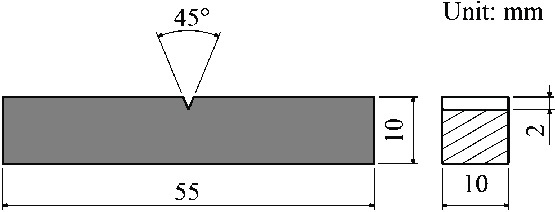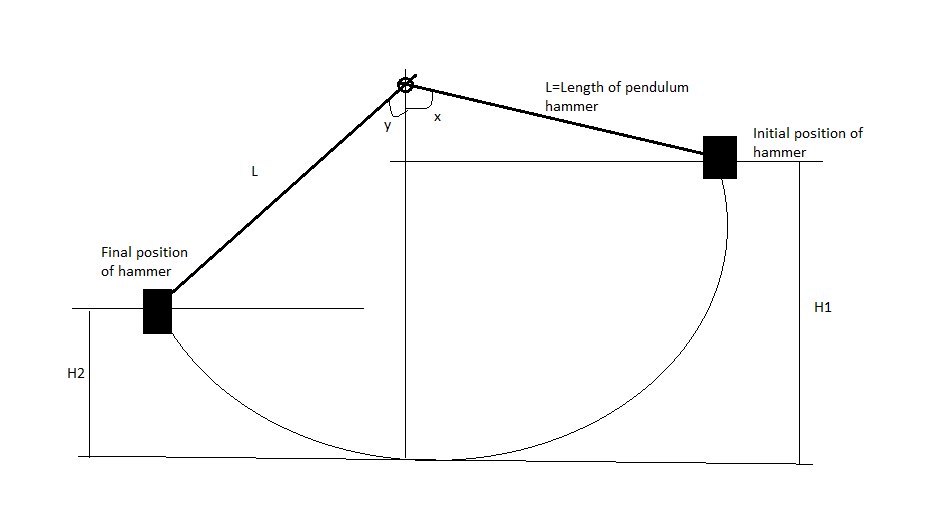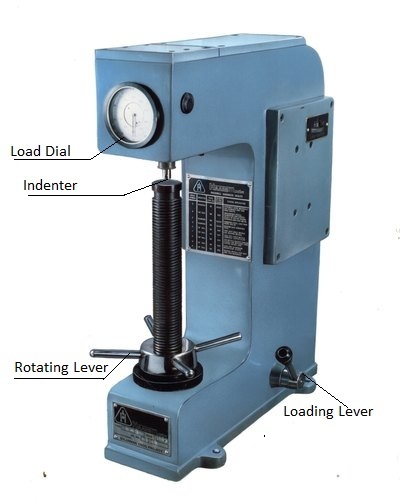Objective: To determine the toughness of a specimen using Charpy Impact Test method.
Theory:
Toughness of a material is defined as its ability to absorb and resist loading (including shock and impact loads) till it gets fractured. There are many ways to test the toughness of a specimen, out of which, Charpy Impact Test is one of the most popular one.
The impact test measures the energy required to fracture a standard notched specimen under the application of an impact load. This measured energy indicates the relative toughness of the specimen.
In Charpy Impact Test, a heavy swinging (pendulum type) hammer is released from a definite height and is made to hit the notched specimen. A part of the potential energy of the hammer is used up in fracturing the specimen and by the virtue of the remaining potential energy, the pendulum continues to swing, but it obviously achieves a lesser height than the height from it was released. The difference in height indicates the energy absorbed by the specimen and thus, its relative toughness.
Apparatus Required for the Experiment:
- Charpy Impact Test machine
- A notched specimen


Charpy Impact Test Procedure
- The Charpy Impact Test machine is made ready and the hammer is locked at a high position by the locker. The corresponding reading of height (=H1) is noted from the dial indicator.
- The specimen is fixed at the specimen support in simply supported horizontal position with the notch facing away from the direction of incoming hammer blow.
- Then, the hammer is released and allowed to strike the notched specimen from back side of the notch.
- As the hammer keeps on rising to the other side after fracturing the specimen, the operator keeps a close watch and the pendulum brake is applied as the hammer reaches its highest possible position.
- The reading of this height of hammer is also noted down (=H2).
Observation and Reading
As mentioned in the procedure, only two height readings of the pendulum hammer has to be noted down as follows:
1. Height of pendulum hammer before release = H1 m
2. Height reached by pendulum hammer on the other side = H2 m
Calculation
- Total potential energy possessed by hammer before striking the specimen = mgH1 joules
- Potential energy left in the hammer after fracturing the specimen = mgH2 joules
- Therefore, net energy spent in fracturing the specimen = mg(H1-H2) joules;
where m=mass of the pendulum hammer (provided in the Charpy Impact Test machine manual)and
g= acceleration due to gravity = 9.81 m/s2.
N.B: In some machines, only angle is displayed in the dial indicator instead of height. In such case, height has to be calculated by the formula given below.
H1= L(1-cosx) and H2 = L(1-cosy), where L=length of the pendulum hammer, x and y are corresponding angles from the central vertical axis as shown below.

QUESTIONS RELATED TO CHARPY IMPACT TEST
- What is Charpy Impact Test used for?
Charpy impact test is used to estimate the toughness of a specimen. - What is the function of pendulum hammer in the test?
The pendulum hammer is used to impart high amount of energy to fracture the specimen. - What kind of specimen is used in Charpy Impact Test?
In this test, the specimen to be used is notched upto a depth of 2mm at an angle of 45 degrees. - In what position is the specimen acted upon by the load?
the specimen is placed horizontally in simply supported condition with the notch facing away from the direction of incoming hammer blow. - Name another test that can be used to determine the toughness of a specimen?
Izod impact Test. - How is the specimen used in Charpy Impact test differ from that in Izod Impact test?
In Izod test the specimen is placed vertically in a cantilever position with the notch facing the hammer while in Charpy test, the specimen is placed horizontally in a simply supported condition with the notch facing away from the hammer blow.



Pingback: WELDING INSPECTION AND TESTING
Pingback: BRINELL HARDNESS TESTER - EXPERIMENT